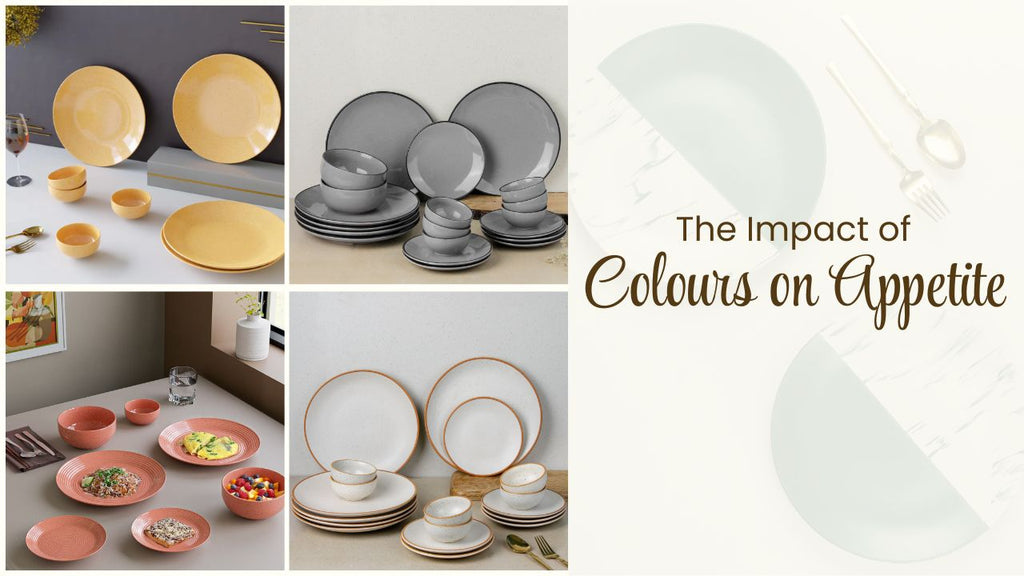How Colour Affects Your Appetite
Posted by MARKETING TES

How Colours Affect Your Appetite: The Psychology Behind Your Plate
Have you ever noticed that certain restaurants use warm tones like red and orange in their décor? Or that your food seems more appealing when plated on a white dish? This isn’t a coincidence—it’s colour psychology at work. Colours influence our perceptions, emotions, and even our physiological responses, including hunger and appetite.
Let’s dig into how colours can affect your appetite and how you can use this knowledge to enhance your dining experience.
The Psychology of Colour and Appetite
Colour psychology is the study of how hues influence human behavior. When it comes to food and dining, colours can either stimulate or suppress appetite. This is due to how the brain interprets visual cues—our first impressions of food are largely based on appearance, and colour plays a central role in that.
Appetite-Stimulating Colours
1. Red
Red is a powerful, emotionally intense colour. It raises energy levels, increases heart rate, and is known to stimulate appetite. That’s why many fast-food brands (like McDonald’s and KFC) use red in their logos and interiors. Red can make food look more appealing and may encourage faster eating.
Use it for: Dining rooms, restaurant interiors, food packaging, or plating rich, hearty meals like pasta or grilled dishes.
2. Orange
Orange combines the energy of red and the cheerfulness of yellow. It evokes warmth, excitement, and enthusiasm, and is also associated with social gatherings. Like red, orange can trigger hunger and make meals feel more inviting.
Use it for: Cozy cafes, buffet areas, or accent colours in your kitchen or dining space.
3. Yellow
Bright and happy, yellow is another colour that can stimulate the appetite. It captures attention quickly and is linked to optimism and freshness. While not as directly appetite-boosting as red or orange, it can create a pleasant, welcoming atmosphere.
Use it for: Breakfast nooks, summer-themed dining setups, and food ads promoting freshness (like citrus or tropical fruits).
Appetite-Suppressing Colours
1. Blue
Blue is rarely found in natural foods (aside from blueberries and plums), which might be why it suppresses appetite. It’s considered calming and serene but also slightly unnatural when paired with food. Some weight loss techniques even suggest using blue plates to reduce food intake.
Avoid it for: Restaurant interiors or dinnerware if you're trying to encourage eating.
Use it for: Settings where you want to promote calmness, like a relaxed tea bar or spa cafe.
2. Gray and Black
Dark colours like gray and black can make food look less appealing or even dull. They are associated with melancholy or seriousness and may reduce excitement around eating.
Use it for: Elegant fine-dining settings (in moderation), or modern plating when paired with vibrant foods for contrast.
3. Brown
While brown can evoke a rustic, homey feel (think: wooden tables, baked goods), it can also feel heavy and unappetizing if overused. It’s a neutral that depends on context—warm-toned brown can feel comforting, while cool-toned brown may feel dull.
Use it for: Traditional, comfort food restaurants, bakeries, or café interiors.
Neutrals and Appetite Perception
White
White is clean, simple, and lets the food take the spotlight. It doesn't alter perception of taste but enhances presentation. Most fine-dining establishments use white plates because they make colours pop and textures stand out.
Use it for: Tableware, minimalistic kitchen design, and formal dining setups.
Colour Tips for Home Dining and Food Businesses
-
For Home Cooks: Use warm-toned placemats, lighting, and plates if you want to create an inviting eating atmosphere.
-
For Restaurants: Align your interior colour palette with the type of cuisine—e.g., rustic earth tones for Indian thalis, vibrant reds and yellows for fast food, or soft pastels for a bakery.
-
For Food Photographers: Plate on white or light neutrals to enhance visual appeal, and use warm backdrops for comfort foods.
-
For Healthy Eaters: Try blue or darker plates to subconsciously eat less or be more mindful.
Fun Fact: Colour Affects Taste Perception Too!
Studies have shown that people often perceive food to taste sweeter, saltier, or more flavorful based on colour—even if it’s the same food. For example, strawberry yogurt in a pink cup may be rated as sweeter than the same yogurt in a blue cup.
Final Thoughts
The next time you sit down for a meal or walk into a restaurant, take a moment to notice the colours around you. Whether you’re trying to stimulate your appetite or cut down on snacking, colour can be a surprisingly powerful tool.
So, what’s your colour palette for dinner tonight?


